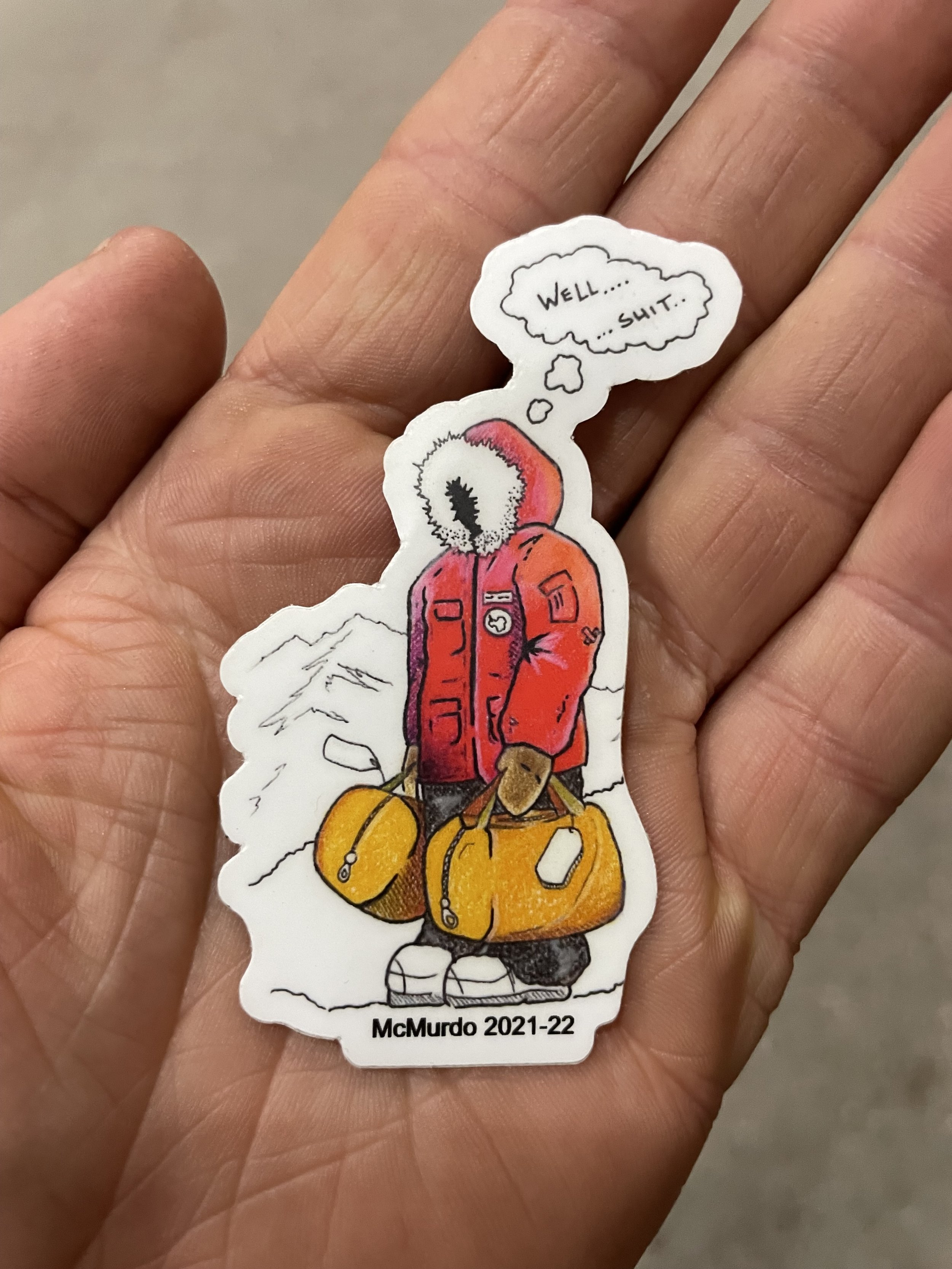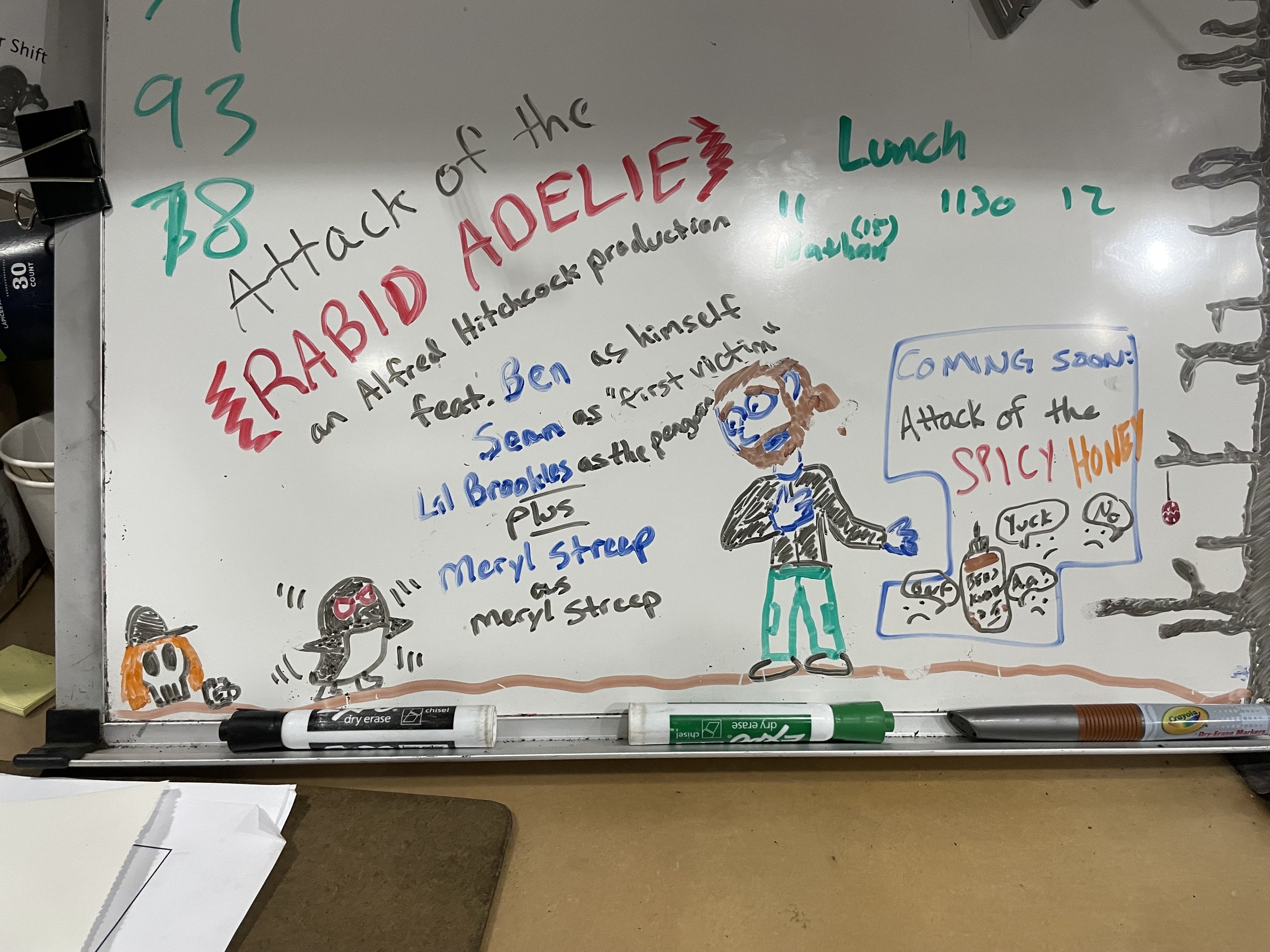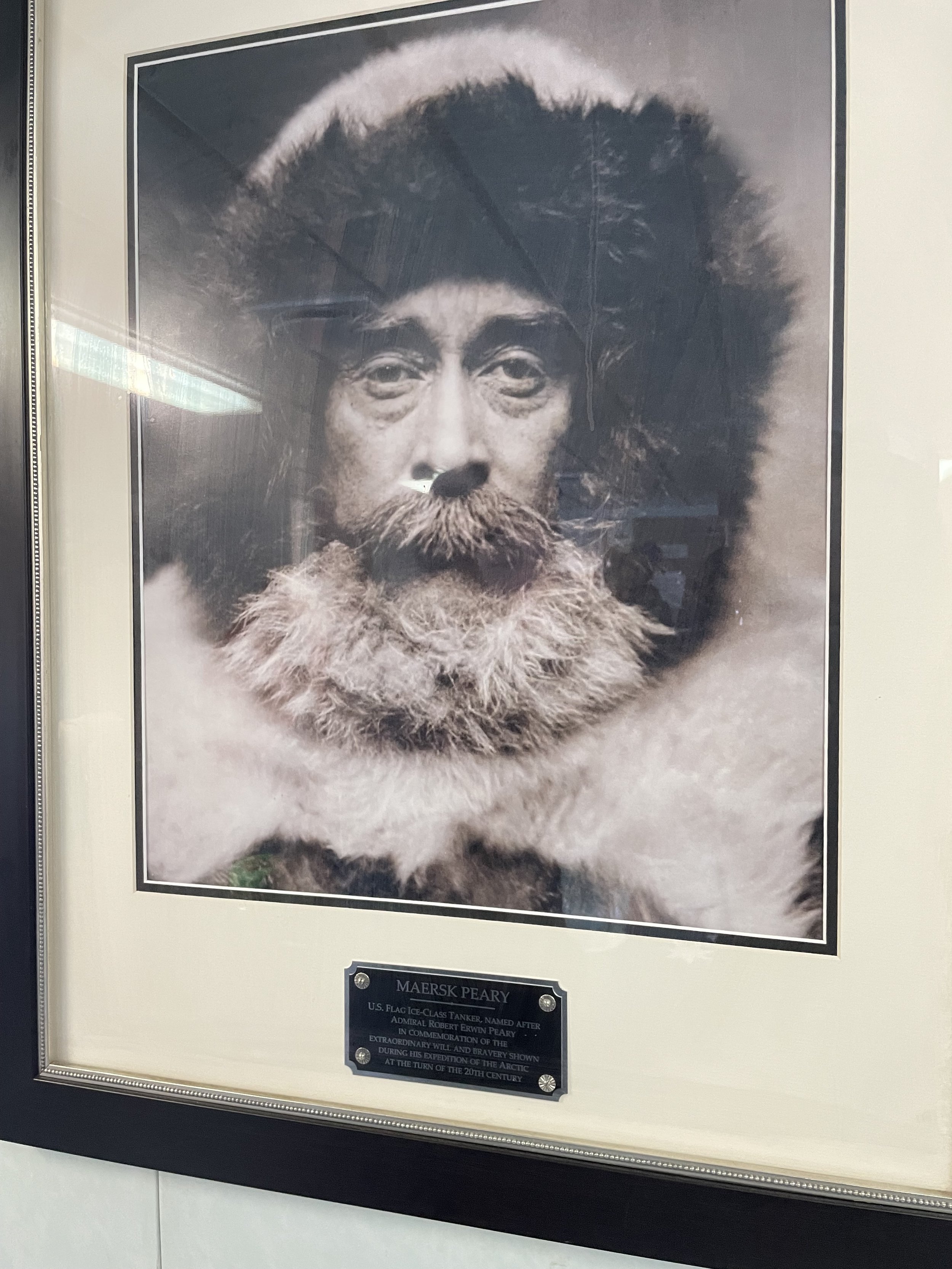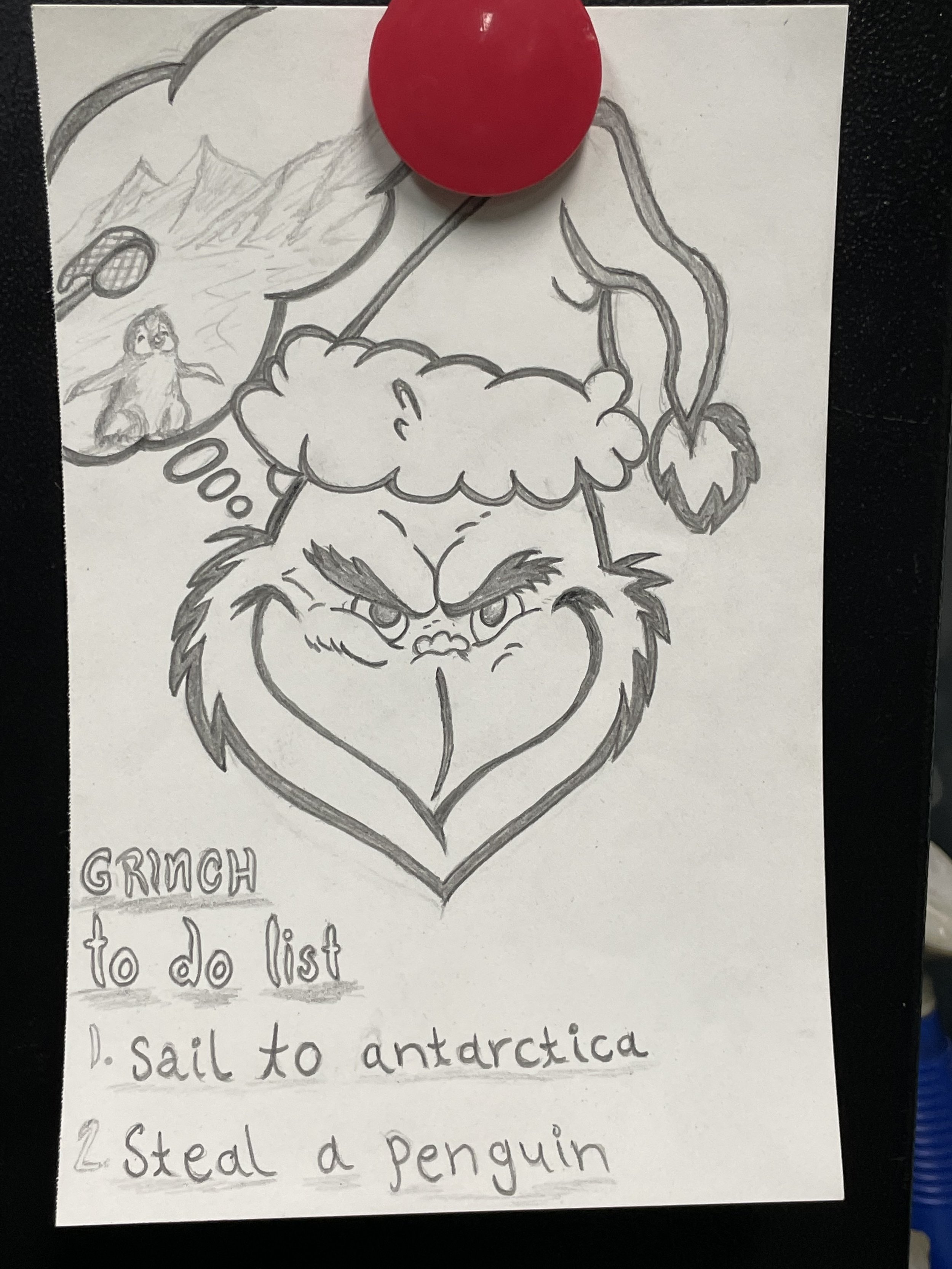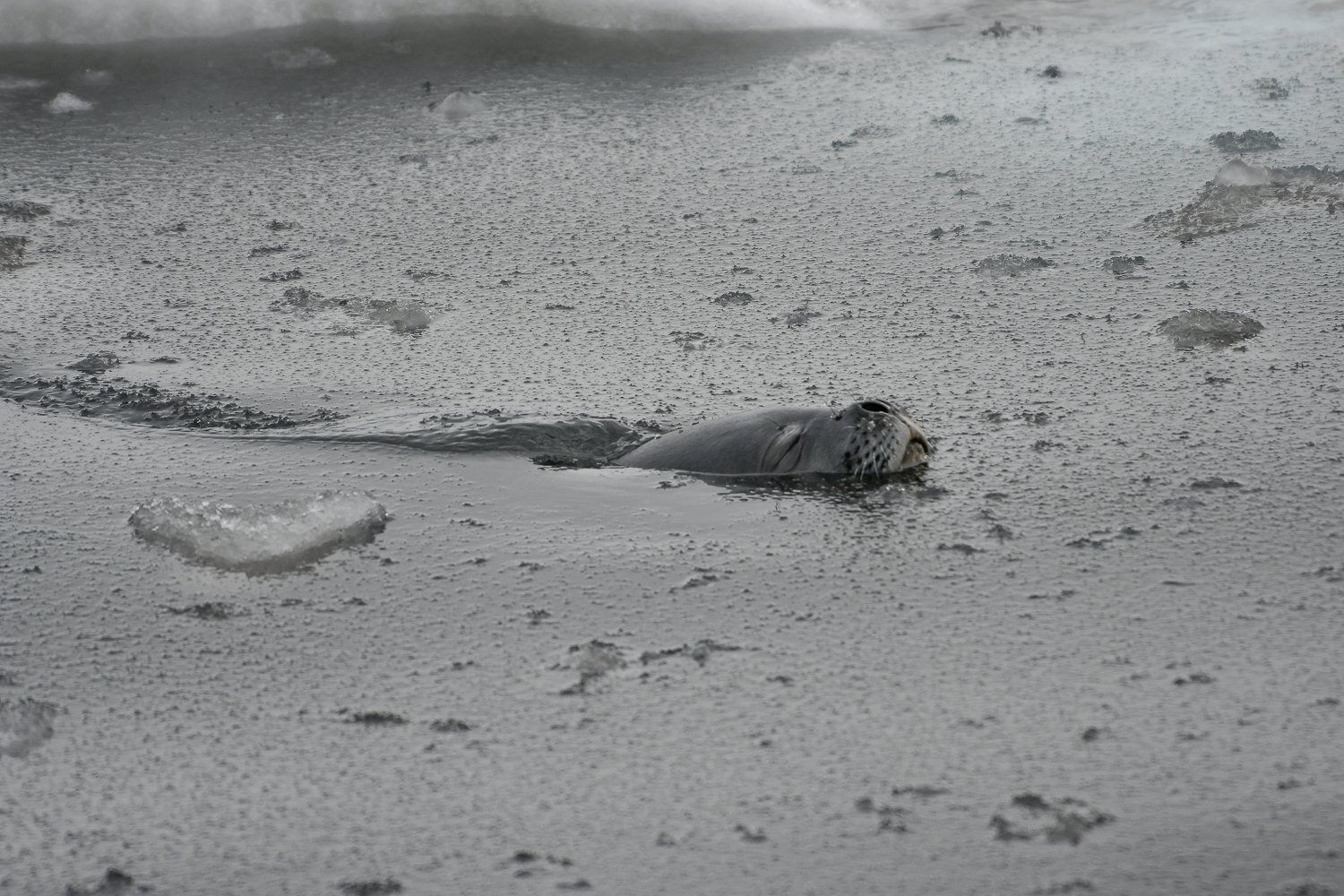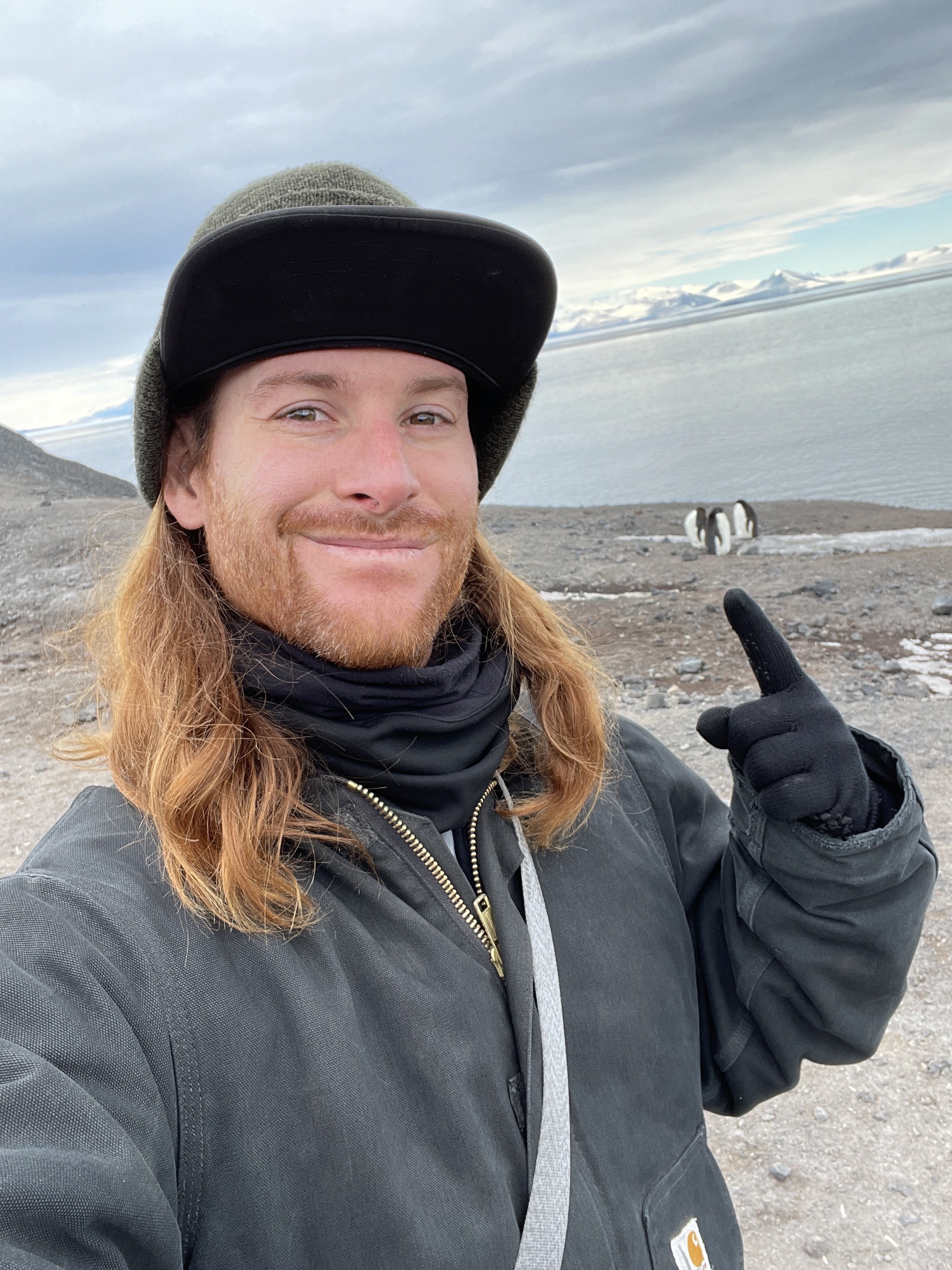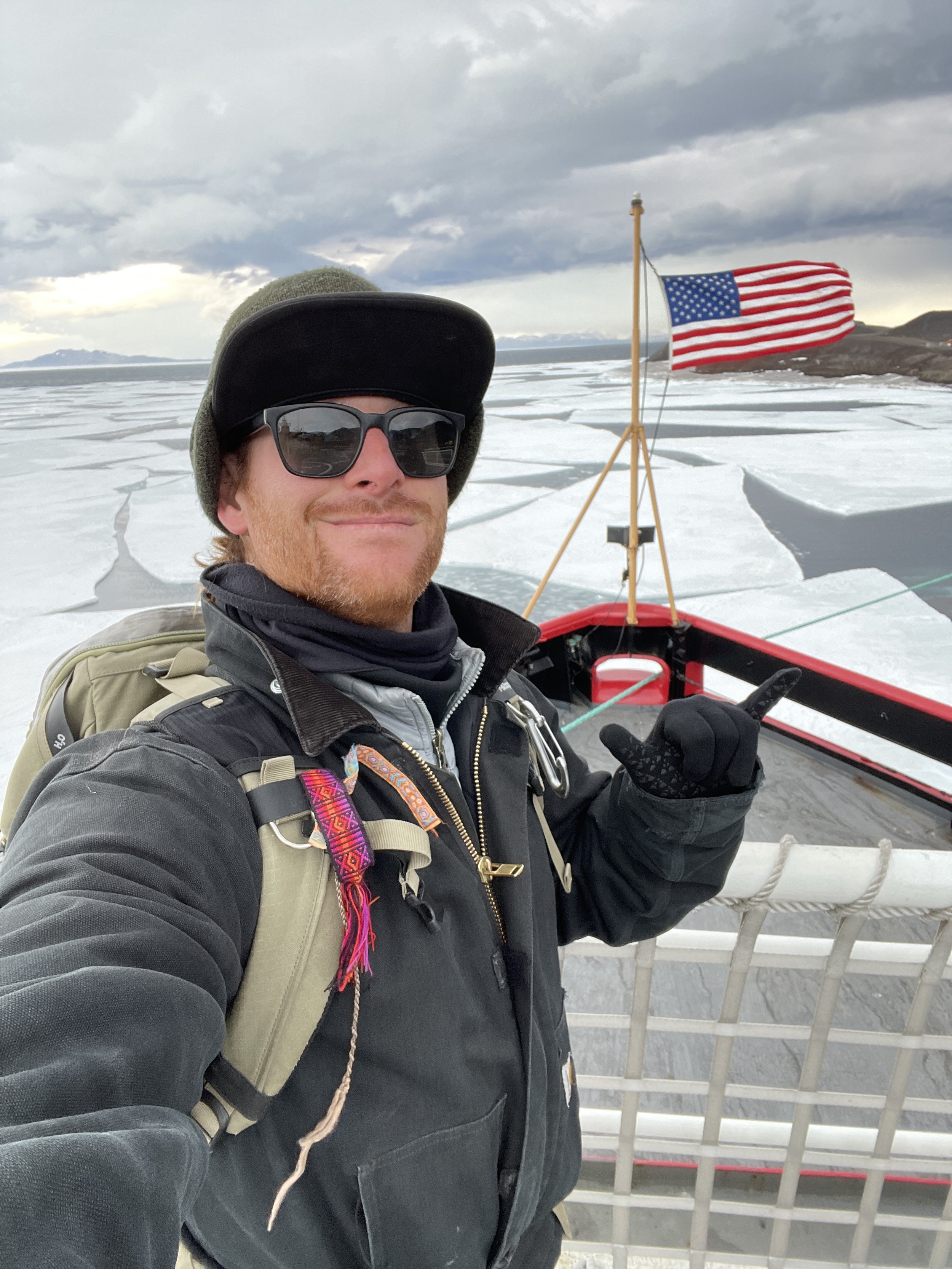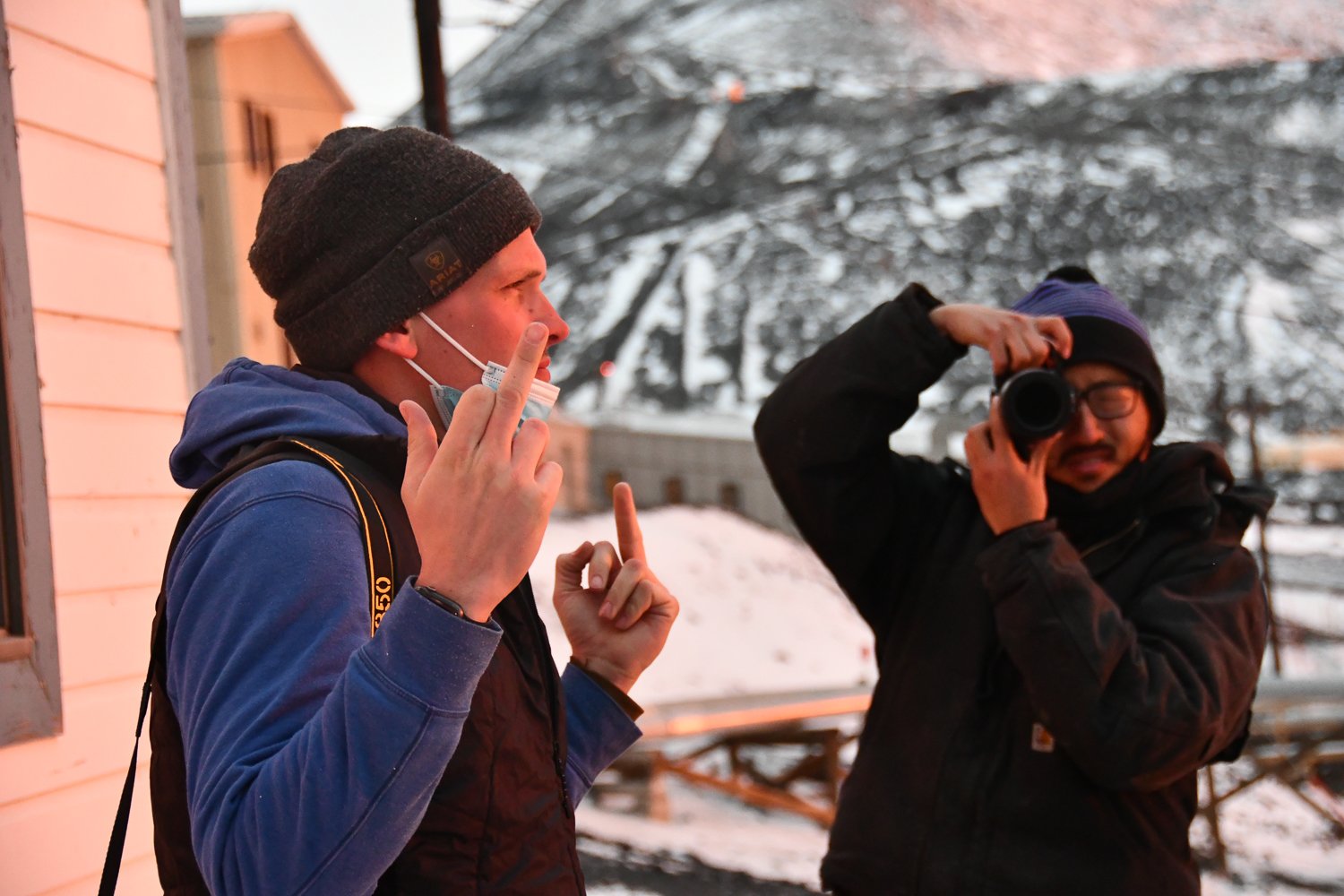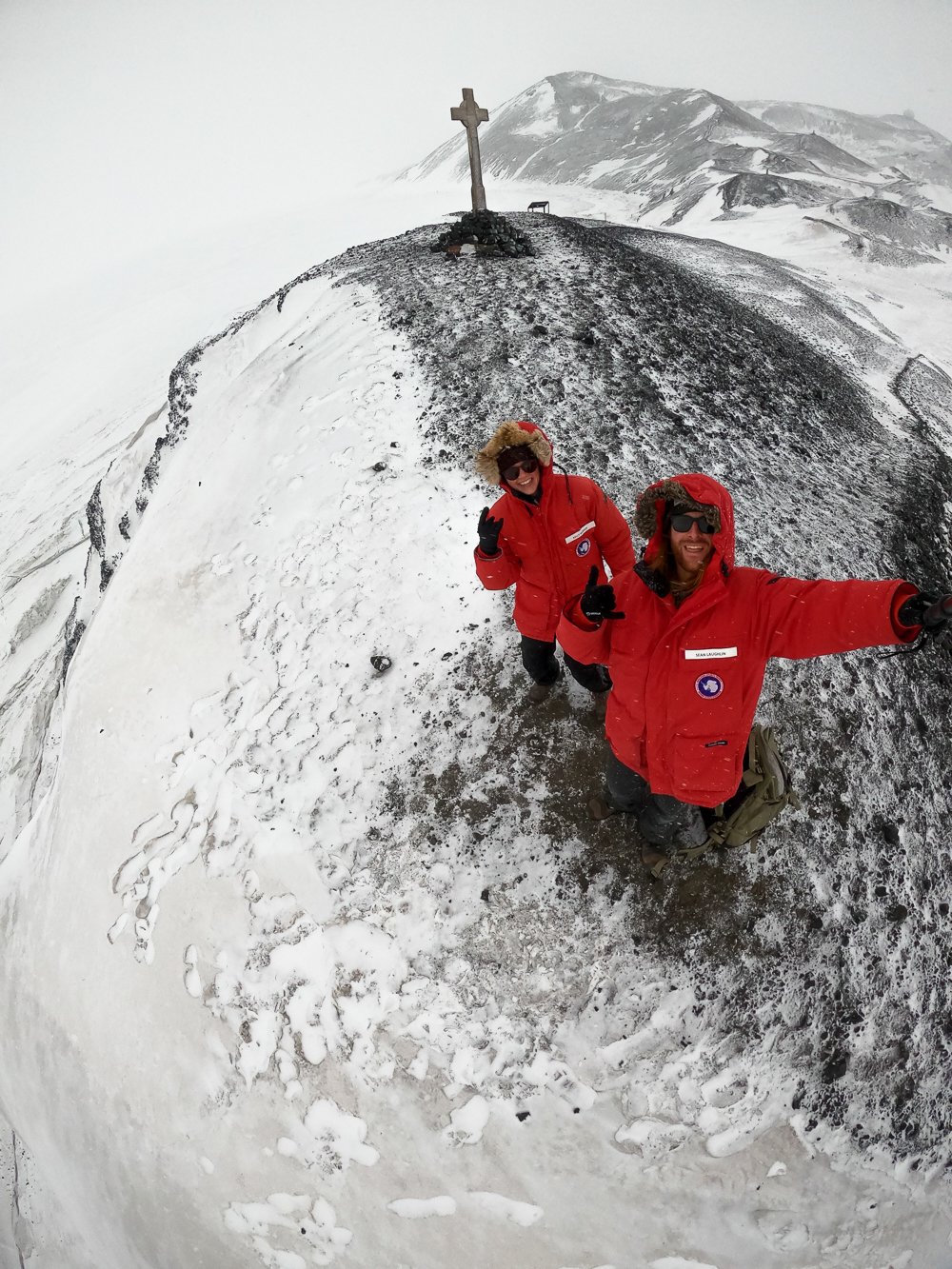The Antarctic Wilds
Week 13
Of course, Cody had to one-up my emperor sighting with a juvenile and managed to hang out long enough to get a stunning photo of the bird shitting.
After that day, though, I headed back out to look for anything and spotted five emperor penguins moving along the ice to head south. I pledged to start coming out at least once a day to check for wildlife.
Tuesday, we were at Williams field working the early shift. I had to take a leak, so I walked out to the bathrooms, and as I was walking up the stairs, I heard a honking sound, but it didn’t sound mechanical, so I walked over to where I thought the sound was coming from. Peering through the fog, I could see the shape of a penguin waddling on the runway. I motioned to one of the firefighters and let him know because we had an airplane taking off, and I didn’t want that little dude to get sashimi’d all over the runway. The firefighters are trained penguin removal professionals, which was one of their main jobs at the station. I radioed my boss Alyssa, and the conversation went, “Heyyy Alyssaaa!” “What, Sean?” “There is a Penguin on the runway” “Copy,” then she rang up the Airfield Manager. She informed him of the situation, which then gets relayed to Terry, our Sheriff, who authorizes penguin removal. We had an important airplane delayed for the next two hours due to the emperor penguin not wanting to get off the runway. It is like he did not understand that the science equipment on the plane was here to help him!
Eventually, they got the penguin off the runway, and the flight was able to leave. After the fog broke, the wind was dead, and it got too hot to wear even a light jacket, so we all enjoyed working outside in just shirts. Hot on the ice is anything above freezing. Right before lunch, I had a group of friends come out and tell me there was an emperor penguin on the road, so I was eager to get a photo of that guy when I was heading out. We had one of the Italian Baslers stop by after lunch to drop off some Italian scientists from the Mario Zucchelli base as they were traveling northbound in a couple of days.
I had one of my heavy equipment operator buddies show me around the D7, which is one of the larger bulldozers. Big toys like that are so fun to operate.
On our way out from Williams field, I kept my eye out for the emperor penguin and saw him hurrying along his belly to the other side of the road. They remind me of a bread loaf when they sit like that.
As the ice kept receding, I spent more of my free time hanging out at Hut point since animal activity had increased. After work one day, right there near the ice pier were three Adelie penguins. I saw a couple last week, but they were so far out on the ice that they looked like rocks in my photos. These three penguins moved about in the water and then made their way to land to rest for the night.
The day before, Cody told me he saw a Minkie whale, so I wanted to hang out today and look for them. We were standing and watching for about an hour, and I asked to see his photos, and right when he showed me his photo, a Minkie whale popped up. I got my camera up and got some shots of its fin. That was my lifer, Minkie whale, which was awesome.
The whaling industry never targeted Minkies, so their populations never took a hit during the time humans hunted whales for their blubber. These whales are on the smaller side, around 25ft in length. They are very fast and navigate in ice packs where ships cannot go through as easily.
One of the funny things about the 21-22 season is how chaotic it had been with Covid and certain rules, so my buddy Frank, the plumbing foreman, made a funny sticker that demonstrated the basic mood for the season with all the chaos.
Week 14
My day off this week was Tuesday, and I was running in the gym and looking onto the ice for a minute. I thought my eyes were tricking me, but there were two emperor penguins right at Hut point, so I ran out of the gym to my room, threw on my cold gear, and then ran down to the point. I met Cody walking back up and he told me they went back into the water about 10 minutes ago. I was super bummed out because I had not had the chance to get a good photo of one up close. That is what it means to be a wildlife photographer, though. You cannot predict what will happen.
My routine was waking up 2.5 hours before my shift, dressing up, and going out to look for wildlife at Hut point. The wildlife is kicking at this time, so I vowed to spend all my free time out looking for the animals. I then would make my way to work, slam down lunch, and head out for another hour. After work, I would get dressed and head out for another two hours to try and get the rarest animal here, the type C Orca, the smallest version of the killer whale. These Orcas are primarily fish eaters and are endemic to the Ross Sea. It is easier to spot the Orca when there is less open water because they are forced to breathe in the open pockets of ice. The Polar Star would keep going back and forth, breaking the ice. The whales liked to follow the ship because it gave them access to new areas.
Around this time, the Navy came in to start preparations for the larger ships arriving soon. The fuel tanker and cargo ship would be the big ones, and that was the top priority due to not having any ships for two years because of Covid. The Navy boys did not know the lay of the land, and with Skua nesting season in full swing, the parents were very protective so when one of them ran past the nest, he got dive bombed by all the parents.
At Hut point, there was the most whale activity I had seen to date. The Minkie whales would take deep breaths and then dive under the ice to get the schooling fish. An interesting thing about whales and dolphins is that you can identify them individually, often by their dorsal fins and tail flukes.
The next day I was at Williams field, a very busy day for the LC-130s. Due to all the action happening, I always had my camera with me. Antarctica is such a unique place, so I wanted to capture everything to share it. That evening when I was out, a group of 15 penguins sat on the edge of the ice.
While there, I was talking with some others who were up around 3 am and saw Orca, so the next morning I woke up at 3:30 am to get out to try and see any Orca as that was my off day. When I got out there, there was absolutely no wind, and the water was glass. I saw a couple of Minkies but no Orca this time.
I went to get breakfast at 5:30 am and took a two-hour nap. After, I got dressed again and headed back out to the point. Seals were swimming back and forth, which is always a joy to see, but I noticed something like a large school of fish jumping. Once I got a better look, I discovered it was a large group of about 25 Adelie penguins hunting. This was my first time seeing them in the water, and it was cool to see them actively hunting.
It was lunchtime, so I went inside and relaxed a little before heading out again. I saw Cody at the galley, and of course, a big group of Orca went right by Hut Point when I was inside. That’s my luck! It seems like all the people were seeing Orcas except me at this point, even though I was putting in serious time.
That night I went hiking at the Observation Hill loop and sat out there since there was a nice air pocket to potentially get an Orca sighting. The ice in this section was visually stunning because it had beautiful shades of glacial blues all over the place. I got a shot of an emperor standing alone. I got a shot of an emperor standing alone and a dead seal carcass scavenged by the Skua.
Week 15
I went out early in the morning but did not see much, and after work, I headed to Hut point and saw a couple of penguins resting out of the water. One gave me a great big stretch, resulting in a very awkward penguin photo. While at the beach, some friends set up chairs and blankets to enjoy a beer in true McMurdo fashion.
I woke up early the next day and saw five emperor penguins’ way out on the ice. It was such a nice time to be out at the point because the wind was not blowing, giving the water a glassy look.
That morning Josh and I had to run to Williams field with the Kress. We parked Lucifer next to Clifford, and they staged Martha, our skid steer, in front for a unique photo. Sometimes you had to set up that good picture because it was hard to take photos when we were working.
That afternoon I made it out to Hut point to check on the wildlife and found three penguins resting on a piece of ice.
The sea ice edge is where all the penguins like to hang out. On this day, I counted 150+ in the surrounding open water. The Polar Star started to come in, and when it got close to the resting penguins, they all stood up and ran away. When they get moving, they put their little wings back and hobble away, honking. It is a pretty, funny site to see.
At this time, it had been two weeks of me constantly visiting Hut point to look for Orcas, particularly because they only come by infrequently and are a rare sight to see. I would take only 15 minutes to eat at the canteen before heading back to the cold to wait patiently for a glimpse of these elusive endemic Orcas. After work, I went out and saw some penguins and a Minkie whale.The best way to search for whales and dolphins is by looking for their spouts, so I routinely checked the horizon with my camera fully extended to try to catch a spout. There was a large open water patch way out, and I saw a spout and was like, oh cool, a Minkie.
I look at the photo and see the unmistakable tall dorsal fin of a male bull Orca and yell out “Orca” to everyone around. I then take my camera, look at the same area, and witness the Orca breach again, but this time I am looking behind it and seeing more spouts going off. I then scan around and see a couple more pods and can see more Orcas as they get closer. They were still far out, but with the naked eye, I could see it was them. I did it! I finally got my type C Orca. This is the pay-off for all the time and effort I put in; to experience this moment, right here with this extraordinary animal. The pods hung out with us for a solid hour, and I left at midnight but with the largest smile of victory on my face.
When I went into work the next day, there was a penguin in front of our garage door, so we could not operate our vehicles due to the treaty stating you cannot disturb wildlife. This one Adelie penguin stopped cargo operations for a whole research station for four hours.
At work, my artistic colleague Brooke made a wonderful art piece depicting this penguin, making me its first victim.
Our penguin friend decided to move up the hill so we could begin operations. Since the penguin was in our area, we had the penguin duty to go out and see where “Buddy” the penguin was so we could mark it, so our vehicles and people would not disturb him. Once they find a spot to molt, penguins will hang there for a while. Molting is not a fun process for penguins as they get rid of their hydrophobic feathers, which means they cannot eat and are colder than usual for 2-3 weeks. That evening I went out to Hut point and caught the Polar Star launching a boat, and it beached, with some coast guard members getting off because they were flying out the next day.
Week 16
Over the last week, most of the sea ice had blown out. The winds typically come from the south, pushing the sea ice out to sea. The start of this week was unusual because a north wind came in and blew all the ice back in and gave it this calm, eerie feeling. The wind died, and I got out there, with the usual crowd of observers with their cameras. Cody, of course, got another Orca that surfaced along a break in the ice. This was a great day, though, because I could see every animal found here aside from the Orca with a swivel of the head. There were emperor penguins and Adelie penguins on the ice. Skuas were flying in the air. We got a Minkie whale to pop up for a breath and because there was no more sea ice, the Weddell seals were swimming about, hoping they did not come in contact with Orcas. The Orcas down here do not typically eat seals, as they have a more fish-heavy diet.
I then walked down to the beach, and the sun came out and illuminated the surrounding area. It was the most gorgeous site I have ever seen. Also, not having the wind seep into your bones was wonderful so I explored the shoreline looking at some of the small creatures that had washed up on shore. The wind had pushed some larger icebergs on the beach, creating cool photos. What is amazing is that the water is so cold, it is like the clearest water on the planet. Touching it was like putting your hand into glass.
The next day I went back to the same spot after work, and all the ice had gotten blown back out. It was overcast, but the tide was all the way out, so I walked along the beach just exploring. It was always cool to see something new especially when we were limited to specific areas due to the protected places and harsh environment. Crazy how we only had that bit of serenity for half a day.
This week we finally had the fuel tanker show up, which was really, impressive to witness coming into port. The Maersk Perry took some time getting here due to some issues with the industry at the time, but it got here with enough fuel to supply the station for the next two years. I signed up to get a tour of the ship and enjoyed learning and seeing how the ship functions. Its engine takes up three stories.
My friend Luke, one of the crane operators, needed some help, so he brought me along to use Fat Cat, one of the largest forklifts on the planet at 90,000 pounds and a load capacity of 60,000 pounds. That is some ridiculous weight. I helped him link the semi-trucks to the trailers, so they would be ready when the Cargo ship, Ocean Giant comes in.
That weekend was the drag show held at Scott Base. What a hilarious event! It was such fun seeing everyone get on stage and perform. A coworker from the states won which was a small victory. I was not aware of the event until the day of, or I would have dressed up like most groovy people at the base did.
The next morning Neil, Chase, and I launched a weather balloon. It happens worldwide at 23:00 Zulu/ Greenwich time when multiple weather stations launch weather balloons to collect atmospheric data.
Week 17
On the way to the airfield in the Kress, I spotted an emperor penguin on the road and had Jake stop so I could get out and take some great photos of this stunning bird. It was young and had just started to shed its coat. This area will most likely be the spot it hangs out for the next couple of weeks while it sheds its feathers. I got to also drive the Kress for a bit, which makes that officially the longest vehicle I have ever operated.
I found a new penguin spot that night. A group of people had created a walking route to look for wildlife every evening. One penguin walked up to me to check me out. He gave me this very disappointed look because he initially seemed to think I was a penguin and when he got closer, he realized I was just a human.
I made my way to Hut point and found four penguins sitting in the sunlight, soaking up that little bit of warmth they get. These four had just started to molt and had chosen this area as their location. From the small hills, they were able to get a nice buffer from the wind.
The sun was perfect this evening, so the Fata Morgana was popping. This is the mirage that happens on the horizon, making things look different than they are. A couple of penguins hopped out of the water and gave us some curious looks while they called to their buddies.
I made it a daily mission to do this route and look for wildlife. A couple more Adelie penguins had shown up. It was also nice to see some lazy Weddell seals up close, playing in the water and resting. When I made it to Hut point, there was a decent wind blowing, and I saw a white bird bolt right past. To my surprise, it was a snow petrel which I was so excited about because I got the first photographic evidence that I had seen the bird. The only time I had spotted them before they were flying way up high.
It was another windy day, and my good North Face jacket's zipper broke. I have had my jacket since 2017 so that was upsetting since now, I needed to use my Carhartt work jacket. I was getting a tour of the Polar Star since it had come into port, and I decided to go to Hut point before my time slot. Three penguins were standing next to each other, and I got some nice photos of them. The most interesting thing happened when the helicopter flew by. They took an interest in what was making the noise, quickly moving their heads all over the place to find out where the noise was coming from.
I made my way to the Ice pier where the Polar Star was docked. The Polar Star is a coast guard ice breaker that launched in 1973. This 399ft ship helps break up the ice for the other ships to move freely in the ocean water and not worry about potentially dangerous ice chunks hitting boats or the ice freezing back over. Before my tour on the ship, there was another north wind that blew a lot of ice back into the McMurdo sound. The seals take advantage of the ice pack when it is in town.
On board the ship, I saw the first green food items I had seen in 2.5 months. Who knew basil could be so exciting?
After the ship tour I returned to Hut point and got a great photo of a seal relaxing right by the beach. The wind started picking up, and I saw that white silhouette that becomes invisible when it goes next to ice and got some good photos of the snow petrel. They are such cool birds and just disappear when they get near the ice, making them so hard to follow with your eyes.
Today is a big day for Antarctica history as the brand-new New Zealand Royal Navy ship, the Aotearoa will be docking at McMurdo today. This ship is state of the art in technology and is a fuel supply ship for others as well as an aide ship for disasters. It was supposed to come in before the Maersk Perry, but Tonga had its volcano explode, so the ship had gone to provide aide and supply the island with fresh water due to its desalination plant on board.
This was our last week working at Williams field, and the fog was insane! I had to move a pallet out to the Basler and could not see 100ft in front of me while operating the loader on the airfield. That afternoon I got a tour of the Aotearoa, and it was fascinating to see the ship's capabilities.
That Sunday, the weather was perfect, so I headed out to Castle rock with Ben, Gary, and Cody. It was so unusual to see the surrounding water without sea ice, as the last time I went out, there was still a lot. Many people had the same idea, so it was fun seeing all the adventurous faces on the hike and at the top, we shared some chocolate and whiskey like a good Antarctician! No clouds were covering Mt. Erebus, so it was perfect for photos.
Finally, the Ocean Giant Cargo vessel appeared early one morning, so I was able to watch it come in while looking for whales. This ship will provide the necessary essential cargo for the station since nothing has been delivered in the last two years due to Covid.
Week 18
This week was full of departures as people are flying back out now that the winter season was approaching. The cargo team was busy getting everything strapped down and ready for the intense cold and wind that envelopes the station during the winter months. The temperature also started to get cold again, being in the teens most of the time. This did not stop me from spending as much of my time left here to go out looking for wildlife. Sunday was the last day we would be able to head to Castle rock, so it was a good thing I headed out when I did because the SAR (Search and Rescue) team stopped all recreational hiking after that because they did not have enough staff left.
February 21st was the main flight where most of the people I had come to call my good friends, would be leaving McMurdo. This was a sad day because it meant I would not get to see these people for a good chunk of time. There were a lot of tears and hugs as everyone made their way to Ivan, the terra bus, to be transported to Phoenix airfield for their C-17 flight. I was originally supposed to be on this flight but opted to stay later because I wanted to spend more time on the frozen continent and get a few more chances for wildlife and sunsets. Heading to lunch was weird because now, only 200 people were around the station.
This night was the first time the sun had set since mid-October. So, it had been four months since I had seen the gorgeous orange and pink colors a sunset brings. I walked out near the chapel and watched as the sun went behind Mt. Discovery. The light pillars cast from each side of the mountain were stunning. The sun came out again, but I was cold and headed into the chapel to wait for the official sunset.
I was joined by Cody and Alex and about 30 minutes later, at 1 am, the colors went crazy! It was honestly one of the most beautiful sunsets I have ever seen.
The next day I did a run out with the Kress to Phoenix field. Sitting at the edge of the ice near Scott base was a large group of emperor penguins. This was the biggest group I had seen together. I snapped a shot and was not happy with it, but I got my proof.
During my lunch break, I took a vehicle out to check on them, and they were all in the water except for a couple standing on the ice near where the Weddell seals like to hang out. Penguins are very awkward on land, but they are spectacularly graceful in their element in the water.
That next day I had to operate Martha, our skid steer, back from the transition, which is the area named for where the dirt roads meet the ice road. I brought my larger lens to get a photo of the flock of penguins. A lot were on their bellies, but it looked like they were just starting to wake up. I concluded that coming back later at night may be best when they are done feeding and all standing up, getting ready to roost.
I went out in the afternoon, and the water was gorgeous. As the cold temperatures started seeping into the ocean, the sea ice began to form but was more like slush. The sound of the ice moving with the waves was pleasant to hear. There are not many sounds on the continent, so when you got to hear something new, it was a fun experience.
Since the Ocean Giant was blocking people from visiting Hut point due to heavy vehicle traffic, I spent most of my outdoor time on the other side of the station. A couple of penguins also liked to hang out around here, and one had quite the hair-do due to molting.
When I had first arrived in Antarctica, I did not have experience operating the loaders behind the C-17. You need to know what you are doing because of the difficult logistics of the operation. We had three C-17s left, and this was my first time being in the loader behind one. I was proud of myself for coming so far in my operator training. It helped to have kick-ass airfield supervisors constantly training me the whole season. I was behind such a large, expensive aircraft where the slightest wrong movement from your fingers can cause millions of dollars’ worth of damage. That is why when you approach the aircraft, the marshaller guides you into the craft, so the forks go in the correct spot for the crew to push the air force pallet on my forks, so I can head out and load it onto the Kress. Next, I collected the outbound cargo and approach the aircraft with it. This offload was exciting as the New Zealand Scott Base will be building a new base, so they were sending a huge excavator that came down on this plane. It is crazy seeing a 50,000-pound vehicle come off an airplane. The C-17s are beasts when it comes to machinery and aircraft.
kept checking the emperor penguins throughout the day to see if I could get that epic shot I wanted to capture. I got off from work a little early and decided to head up to the top of Observation hill one last time, so I could get a good photo of the surrounding open ocean.
The penguins were in the water, but I did notice some immense icebergs calving off from the Ross ice shelf and what is insane is how cut and straight the lines were on the pieces that were calving off.
I got the chance to work one more C-17 as that would be my last time since I would not be working the aircraft I would be flying out on. Later that night, I took a van to Scott Base to check out the penguin’s colony. They were all standing up in perfect formation. There were around 60 of them, and I shifted around the area to get different angles of the flock. I finally got the photos I wanted after trying for the last week.
Week 19
This week I hung back, packed, and enjoyed the time I had left on this epic frozen wasteland I had called home for the last five months. There were some great farewell parties for us to say goodbye to the people staying for winter. My last official duty was loading all the bags into a bag frame and loading that onto the Kress one last time before putting on my gear and heading out to the airfield to wait for the plane. We all got into our ECW gear and said our goodbyes to the winter crew. Once we got to Phoenix airfield, we set out to find our teammates who were staying for winter and said our goodbyes to them. There was a light snow falling while we waited for the C-17. I waited outside because it would most likely be a very long time before I got to experience this feeling of the Antarctic cold again. There is something magical about it. There were 120 of us flying out on this flight, and we all were chatting about the good times we had during the season when we spotted that grey dot in the sky. As it came closer and the aircraft's shape increased in size, I realized it was happening. I was leaving this winter wonderland.
The C-17 landed, and we all got to the vans to head out onto the airfield while waiting for the offload of the aircraft. Since I was part of flight crew, I got to head out first to the airplane which also meant our bags were on top and the first to come off in New Zealand. This was my first time flying in a C-17 because on the way down here, I flew in a B757. The seats are configured differently than in a conventional airplane, and we also had cargo in the back of the plane. We sat sideways, facing the wall when cargo was on the aircraft.
It was very cold on the plane, so we had all our gear on and got ready for takeoff. As soon as those wheels lifted off the runway, it truly hit me that I was leaving. About an hour into the flight, it started to get warmer, and we changed into normal clothes. We could move freely throughout the cabin, which I thought was cool because we had space to stretch and move around. There were three windows where you could look outside, and I got some last photos of the surrounding frozen continent. The glaciers, jagged mountain peaks, and howling winds are things I will miss.
We landed five hours later in Christchurch, New Zealand, around 11 pm. When I stepped outside, it was the first time I had seen the night sky in 5 months. I had to take a minute to let that realization soak in. After picking up my bags, we had to move to USAP headquarters to drop off our ECW gear and get a ride to the hotel. On the way there, I was able to smell plants and a multitude of scents in the air. There were actual smells aside from penguin poop and nothingness.
On March 5th, I was scheduled to fly home and prepare for my next adventure. We had 72 hours in Christchurch where we needed to take a Covid test and finalize our contract. It was nice to see people and walk around a city, seeing trees, dogs, and insects for the first time after five months.
Thank you for reading my blog. It means the world to me that people pay attention to this crazy wild adventure I get to call my life. I hope you learned a lot about life at a research station in Antarctica. I hope one of your main takeaways from reading this is to follow your goals, and when life throws you a curveball like Covid, you should adapt and work out a way to fulfill those goals anyway. Getting to Antarctica was my biggest goal at the time, and I made that happen. Another takeaway is that you do not need to be a scientist to work in Antarctica. There are hundreds of positions on the ice. Since the USA has the largest station on the continent, it is easier for people holding a USA passport to get down to the ice. But even if you have another passport and your country has a station on the continent, check with them about what seasonal jobs they have down there. Stay wild, everyone.














